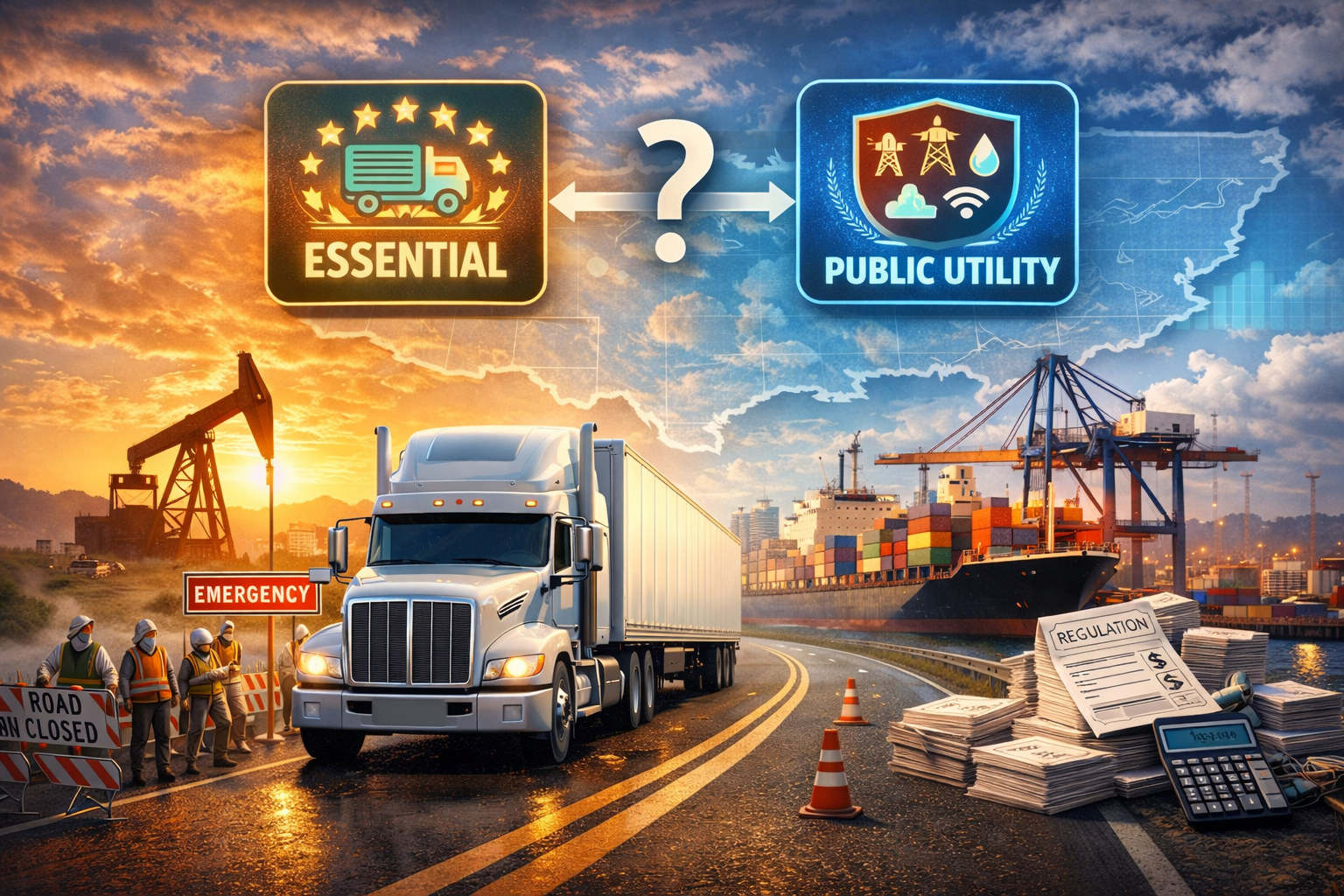Top Reasons Motor Carriers May Go Bankrupt in Late 2025
Share this Article:

August 4, 2025
The second half of 2025 will be one of the most unforgiving periods in recent history for small and mid-sized motor carriers in the United States. While freight volumes have remained steady, the financial and legal landscape surrounding trucking has grown hostile—marked by escalating costs, regulatory burdens, and economic volatility. Bankruptcy filings by carriers have surged in the first half of the year, and the pressure will only intensify.
For those in leadership—owners, CFOs, fleet managers—understanding the core risks is not just helpful; it is essential to survival. This article breaks down the top reasons why a motor carrier is likely to go bankrupt in H2 2025, with a focus on critical factors including insurance costs, legal exposure, interest rates, tariffs, and broader consumer behavior.
Soaring Insurance Costs and Shrinking Availability
The trucking insurance market in 2025 is increasingly dominated by high deductibles, nuclear verdict risk, and a shrinking pool of underwriters. For many carriers, insurance is now the second-highest fixed cost after fuel or payroll—and it’s growing faster than any other line item.
Key Factors:
- Annual premiums often exceed $25,000–$35,000 per truck.
- Deductibles have ballooned to $50,000–$100,000 in many policies.
- Insurers are exiting high-risk states (e.g., California, Texas), leaving carriers scrambling.
Carriers with even one minor CSA score blemish or prior accident claim may find themselves uninsurable or priced out, especially if they operate older equipment or haul higher-risk freight like hazmat or produce.
Bankruptcy Trigger: A single loss of insurance coverage (or a 2x rate hike) can effectively shut down operations overnight, as FMCSA registration depends on valid insurance.
Lawsuits and the Rise of Nuclear Verdicts
Legal risk is one of the most underestimated threats to a motor carrier’s financial survival. Trial attorneys across the U.S. have aggressively targeted trucking companies, using dashcam footage, driver logs, and company records to build high-value cases—often with jury verdicts exceeding $10 million.
Common Scenarios:
- A distracted or fatigued driver causes a multi-vehicle collision.
- Failure to properly maintain brakes or tires leads to injuries.
- Inadequate driver training or lack of documentation becomes evidence of negligence.
Even carriers who are partially at fault or not negligent can face years of litigation, settlements, and rising insurance reserves. The mere threat of a nuclear verdict can push insurers to settle high, raising premiums for the entire fleet—and damaging a company’s ability to grow or retain shippers.
Bankruptcy Trigger: A single judgment over policy limits may force the fleet owner to liquidate assets or restructure under Chapter 11.
High Interest Rates and Cost of Capital
As of Q3 2025, the Federal Reserve has held interest rates near 5.25%, and inflation remains sticky despite early-year optimism. This has a direct and punishing effect on leveraged motor carriers.
Financial Impacts:
- Truck and trailer financing rates are now 9%–13%, depending on credit.
- Lines of credit have become tighter and more expensive.
- Carriers with equipment loans or factoring arrangements face growing interest burdens.
Moreover, smaller carriers—especially those dependent on factoring companies for working capital—are exposed to predatory terms, leaving them with little room for error if freight invoices are delayed or disputed.
Bankruptcy Trigger: Interest burdens squeeze margins to the point that even profitable operations can’t maintain liquidity, resulting in missed payroll, repossessions, or default.
Tariffs and Cross-Border Trade Friction
While tariffs are usually discussed in geopolitical terms, their effects are very real for motor carriers—especially those involved in import/export freight, intermodal drayage, or cross-border hauling with Mexico or Canada.
The Trump administration’s 2025 trade bill—commonly referred to as the One Big Beautiful Bill—introduced a new wave of tariffs on consumer goods, electronics, and components from China, the EU, and Mexico. In response, several trading partners have retaliated, causing supply chain disruption and freight slowdowns.
Freight Market Consequences:
- Tariffs have led to order delays and reduced freight volume.
- Retailers and manufacturers are stockpiling less, lowering the need for transportation services.
- Uncertainty is shifting supply chains toward domestic production, which could reduce cross-border hauls in the short term.
Bankruptcy Trigger: Declining international or port-related freight causes revenue shortfalls that carriers can’t offset quickly enough with domestic lanes.
Consumer Index & Freight Demand Volatility
The U.S. Consumer Confidence Index (CCI) and Consumer Spending Reports for Q2 2025 have been underwhelming, driven by inflation fatigue, rising credit card debt, and continued layoffs in white-collar sectors.
What does this mean for motor carriers?
Domino Effect:
- Retail and discretionary goods freight is softening.
- Final-mile and regional carriers are particularly vulnerable.
- Spot market rates for dry van and reefer freight have declined by 12–18% year-over-year.
- Inventory levels are leaner, and warehouse throughput has slowed.
Even contract carriers are seeing delays in RFP renewals, while some shippers are rebidding mid-cycle to lower their freight spend.
Bankruptcy Trigger: Revenue drop, especially in Q4 peak season, combined with fixed operating costs, forces negative cash flow for consecutive months.
Failure to Maintain Compliance & Rising Operating Costs
Beyond fuel and insurance, compliance has become more expensive and harder to manage. States have intensified audits of:
- Sales and use tax filings
- IFTA and HVUT registrations
- Driver employment classification (W-2 vs. 1099)
- Equipment depreciation and use exemptions
Fines for non-compliance are high and often retroactive. A small fleet that misclassifies drivers or fails to update multi-state registrations can face six-figure back taxes and penalties—often without warning.
Additionally:
- Tolls are up in 27 states as of mid-2025.
- Several states have introduced new vehicle miles traveled (VMT) fees.
- Some states are auditing IRP apportionment data with new algorithms.
Bankruptcy Trigger: Surprise assessments or penalties can destroy margin and credibility with lenders, landlords, and shippers.
Unprofitable Growth or Overexpansion
Ironically, many carriers that are filing for bankruptcy in 2025 are not failing due to lack of freight—they’re failing due to expansion without financial discipline.
Carriers that:
- Added trucks rapidly during the 2021–2022 boom
- Failed to lock in stable contract freight
- Took on high-interest equipment loans
- Didn’t invest in compliance, training, or tech
…are now facing a perfect storm of declining rates and rising costs.
Bankruptcy Trigger: Fleet size outpaces management capability, resulting in driver turnover, asset underutilization, and default on fleet loans.
Owner Burnout and Exit Without Planning
In many small and family-owned carriers, the owner is also the CFO, dispatcher, recruiter, and compliance officer. The emotional and mental weight of managing insurance renewals, lawsuits, breakdowns, and driver shortages is taking its toll.
In H1 2025, over 1,400 carriers filed for bankruptcy—many of which were profitable on paper but suffered from burnout, lack of succession planning, or inability to refinance loans.
Signs of Burnout-Induced Closure:
- Owner begins delaying IFTA, registration, and maintenance filings.
- Payroll starts to slip, and key staff leave.
- Owner stops bidding on new lanes or pursuing growth opportunities.
Bankruptcy Trigger: Emotional disengagement leads to inertia, and the business collapses from within—even without catastrophic loss.
Final Recommendations: How to Avoid the Cliff
If you're a motor carrier executive or owner reading this, here’s how to proactively avoid bankruptcy:
Financial
- Conduct a 12-month cash flow forecast under three rate scenarios.
- Refinance any high-interest debt before Q4.
- Use factoring selectively—avoid contracts with monthly minimums or hidden fees.
Legal & Compliance
- Perform a risk audit with legal counsel.
- Review every driver’s DQF, MVR, and training file.
- Invest in accident response protocols and dashcams.
Strategic
- Diversify into specialized freight (e.g., flatbed, hazmat, intermodal drayage).
- Build direct shipper contracts rather than relying on brokers.
- Reinvest in technology: TMS, compliance tracking, and freight optimization tools.
In Closing: Survive Now, Thrive Later
The second half of 2025 will be remembered as a cleansing cycle for the trucking industry. Carriers that ignored risk management, over-relied on spot freight, or failed to adapt to rising capital costs will struggle—or fold.
But those that take action now—by improving compliance, reducing legal exposure, and managing debt—can not only survive but emerge stronger when the market rebounds.
The road ahead is rough. But it's not impassable.
Share with Us:




